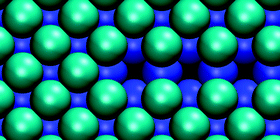Energetics and kinetics of vacancy diffusion and aggregation in shocked aluminium via orbital-free density functional theory
Abstract
A possible mechanism for shock-induced failure in aluminium involves atomic vacancies diffusing through the crystal lattice and agglomerating to form voids, which continue to grow, ultimately resulting in ductile fracture. We employ orbital-free density functional theory, a linear-scaling first-principles quantum mechanics method, to study vacancy formation, diffusion, and aggregation in aluminium under shock loading conditions of compression and tension. We calculate vacancy formation and migration energies, and find that while nearest-neighbor vacancy pairs are unstable, next-nearest-neighbor vacancy pairs are stable. As the number of nearby vacancies increases, we predict that vacancy clusters preferentially grow through next-nearest-neighbor vacancies. The energetics are found to be greatly affected by expansion and compression, leading to insight as to how vacancies behave under shock conditions.


 Please wait while we load your content...
Please wait while we load your content...